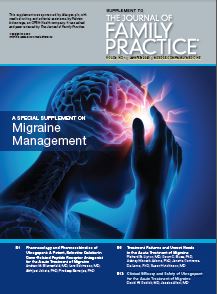 A significant unmet need exists for users of acute medications for the treatment of migraine attacks. These medications can be ineffective or associated with undesirable side effects. However, a novel unique therapy, ubrogepant, has demonstrated efficacy for the acute treatment of migraine.
A significant unmet need exists for users of acute medications for the treatment of migraine attacks. These medications can be ineffective or associated with undesirable side effects. However, a novel unique therapy, ubrogepant, has demonstrated efficacy for the acute treatment of migraine.

Click here to read this supplement.
Patient Handout:
Supplementary Podcasts:
General Migraine Background
1. Treatment Patterns and Unmet Needs in the Acute Treatment of Migraine
2. Pharmacology and Pharmacokinetics of Ubrogepant: A Potent, Selective Calcitonin Gene-Related Peptide Receptor Antagonist for the Acute Treatment of Migraine
3. Clinical Efficacy and Safety of Ubrogepant for the Acute Treatment of Migraine
Podcast References
1. Burch R, Rizzoli P, Loder E. The prevalence and impact of migraine and severe headache in the United States: figures and trends from government health studies. Headache. 2018;58(4):496-505.
2. GBD 2017 Disease and Injury Incidence and Prevalence Collaborators. Global, regional, and national incidence, prevalence, and years lived with disability for 354 diseases and injuries for 195 countries and territories, 1990-2017: a systematic analysis for the Global Burden of Disease Study 2017. Lancet. 2018;392(10159):1789-858.
3. Evers S, Marziniak M. Clinical features, pathophysiology, and treatment of medication-overuse headache. Lancet Neurol . 2010;9(4):391-401.
4. Ahmed F. Headache disorders: differentiating and managing the common subtypes. Br J Pain. 2012;6(3):124-32.
5. Minen M, Shome A, Halpern A, Tishler L, Brennan KC, Loder E, et al. A migraine management training program for primary care providers: An overview of a survey and pilot study findings, lessons learned, and considerations for further research. Headache. 2016;56(4):725-40.
6. Becker WJ. Acute migraine treatment in adults. Headache. 2015;55(6):778-93.
7. Marmura MJ, Silberstein SD, Schwedt TJ. The acute treatment of migraine in adults: the American Headache Society evidence assessment of migraine pharmacotherapies. Headache. 2015;55(1):3-20.
8. Bigal ME, Lipton RB. Excessive acute migraine medication use and migraine progression. Neurology. 2008;71(22):1821-8.
9. Messali AJ, Yang M, Gillard P, Tsai K, Tepper SJ, Bloudek LM, et al. Treatment persistence and switching in triptan users: a systematic literature review. Headache. 2014;54(7):1120-30.
10. Katic BJ, Rajagopalan S, Ho TW, Chen YT, Hu XH. Triptan persistency among newly initiated users in a pharmacy claims database. Cephalalgia. 2011;31(4):488-500.
11. Iyengar S, Ossipov MH, Johnson KW. The role of calcitonin gene-related peptide in peripheral and central pain mechanisms including migraine. Pain. 2017;158(4):543-59.
12. Ho TW, Edvinsson L, Goadsby PJ. CGRP and its receptors provide new insights into migraine pathophysiology. Nat Rev Neurol. 2010;6(10):573-82.
